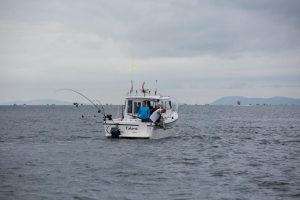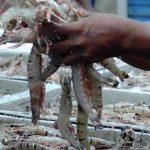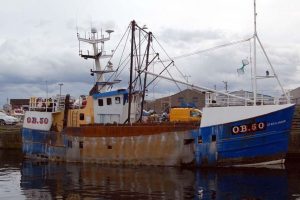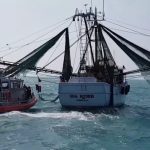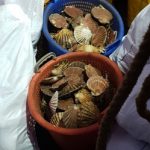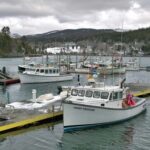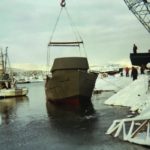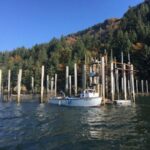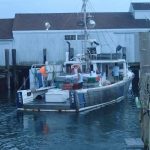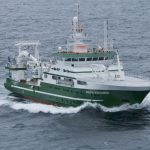Tag Archives: Scallop Industry.

New England scallopers face a tough 2025
New England scallopers are looking at another tough year in 2025, as they prepare for a set of federal regulations to protect both their livelihoods and the Atlantic Ocean’s scallop populations. If approved by NOAA Fisheries, the new rules, called Scallop Framework 39, will reduce the number of times that full-time vessels can go drag in some federally-managed scalloping grounds — called “access areas” — in the 2025 fishing year. But they will allow these vessels more time to scallop in the open ocean. The start of the access-area scalloping season will also be pushed back from April 1 to May 15, 2025. It will end on March 31, 2026. Local scallopers and industry representatives say the contents of Framework 39 are not a surprise. Landings have been shrinking over the past four years. “We’re just tightening the belt, and taking a deep breath, and riding the storm out,” said New Bedford scallop vessel manager and owner Tony Alvernaz. more, >>CLICK TO READ<< 17:50
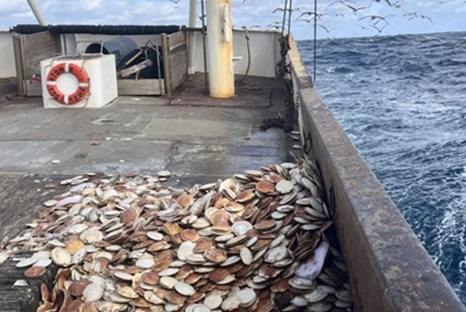
Scallopers assail continued closure of Northern Edge
Fisheries regulators voted this month to “discontinue” development of a plan to reopen the Northern Edge of Georges Bank — a lucrative scallop ground that has long been closed to commercial fishing. In April, the New England Fishery Management Council agreed to consider requests to reopen the fishing grounds at the urging of both the scallop industry and Mayor Jon Mitchell. He and industry representatives cited significant headwinds for the region’s top fishery, including a slump in prices and fewer days at sea for fishermen. They added that opening the Northern Edge would benefit the whole port economy and surrounding businesses. But in the midst of a four-day meeting in Freeport, Maine, the Council voted not to continue discussing plans to reopen the area in order to focus on the “long-term productivity of the Georges Bank scallop resource.” For regulators, it’s a balancing act to weigh sustainability and the economic pressures on fishermen to sustain their livelihoods. more, >>CLICK TO READ<< 17:43

New England Fishing Culture
In New Bedford, fishing is more than a business—it is a way of life, passed down through generations of families like a tradition instead of an occupation. Born into a family of fishermen, Tyler Miranda grew up on the water, going out on trips in his father’s lobster boat—a wooden vessel about 14 feet long and half-covered in ocean-worn lobster traps—since he was six. Kellen O’Maley, a fisherman from Gloucester, Mass., chose not to pursue opportunities using a business degree. (Gloucester, a town two hours north of New Bedford, is the second largest fishing port in the state.) Instead, he dove into the fishing industry. >click to read< 10:19
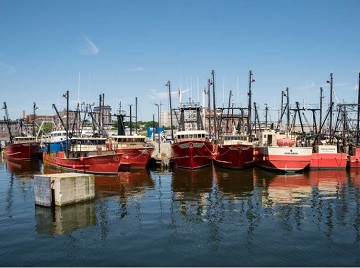
Investigation reveals private equity firms dominate the New Bedford fishing industry
A debate is raging in the local scallop industry about whether fishermen should be allowed to lease their permits. Supporters say the proposal could help fishermen with a small catch share, or those who can’t get out to sea, stay in the business, because they could lease their permit to another captain. Opponents worry it would allow big companies to consolidate the industry and push small fishermen out, similar to what has happened in the groundfishing industry. CAI’s Kathryn Eident talked with Will Sennott, a reporter with the New Bedford Light, about his investigation into permit leasing in the groundfishing industry, and how he found that some of the biggest winners are multinational private equity firms, not small fishermen. >click to read< 16:21
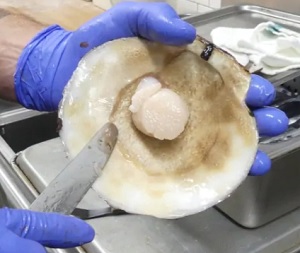
America’s scallop harvest projected to decline again in 2022
The decline in scallops is happening as prices for the shellfish, one of the most lucrative seafoods in America, has increased amid inflation and fluctuations in catch. Seafood counters that sold scallops for $20 per pound to customers two years ago often sell them for $25 per pound or more now. U.S. scallop fishers harvested more than 60 million pounds of scallops in 2019, but the catch has declined since, and fishers were projected to harvest about 40 million pounds of scallops in the 2021 fishing year. That number is projected to fall to 34 million pounds in the 2022 fishing year, which started this spring, according to the New England Fishery Management Council. >click to read< 13:48

Scallop fishermen and industry advocates call for changes to proposed NY Bight offshore wind farm area’s
In an online call with Bureau of Ocean Energy Management (BOEM) officials, industry representatives highlighted the need for a buffer zone to protect the most valuable scallop area in the Mid-Atlantic and expressed concern over environmental and fisheries impacts of offshore wind development generally. Proposed lease areas need to be thoroughly re-evaluated to reduce impacts to scallops and scallop fishermen, who operate in the most valuable federally managed fishery. >click to read< 13:36
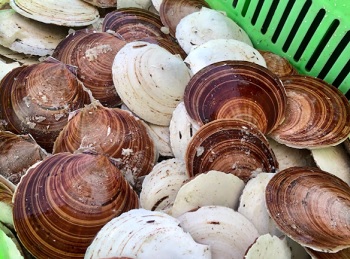
Queensland’s scallop industry in doubt
Fisheries Queensland says recent figures show scallop numbers are in serious decline with the biomass, or the amount that can be fished, dropping to 12 per cent of 1977 levels. But Queensland Seafood Industry Association treasurer and scallop fisherman Kevin Reibel said completely closing the fishery would be devastating to south-east Queensland communities. >click to read< 22:00
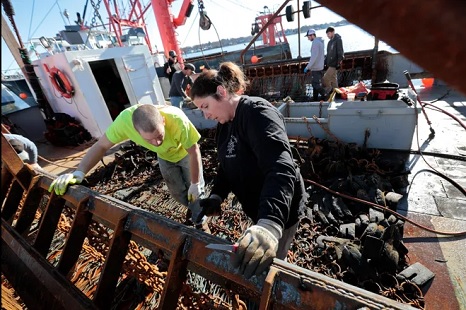
Women of New Bedford’s Waterfront
Captain Jessica Walker, 34, first stepped foot on a commercial fishing vessel, which happened to be the Legacy, when she was 19. The college history major was looking for a summer job and this one was far from “potato country”, the place in Northern Maine she called home. She started with summer trips that eventually became full-time work. She worked her way up to mate and learned everything from the boat owner and previous captain, David Wilhelmsen. When he stepped down, Walker assumed the role of captain in the summer of 2013. Further up in the harbor, fishing vessel Reliance was docked earlier in the week for maintenance before departing for the next scalloping trip. Two men with welding helmets sat on the deck repairing the metal gear while Crystal Vaughan stood up in the wheelhouse attending to inventory. 21 photos, >click to read< 10:20
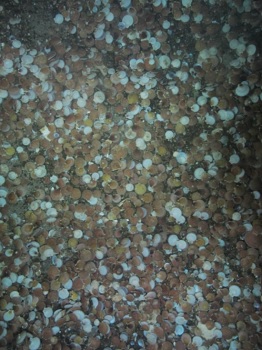
Stokesbury’s image-based, drop camera survey has been pivotal in the revival of the scallop industry
Stock assessment is one of the many key areas of research being conducted by several professors at UMass Dartmouth’s School for Marine Science & Technology (SMAST). Efforts led by Professors Steve Cadrin, Pingguo He, and Kevin Stokesbury help characterize how offshore wind development interacts with the marine environment, including important fisheries and critical habitat. Their findings are also critical in advancing offshore wind in a sustainable manner while minimizing impacts to existing marine activities and resources. >click to read< 13:34
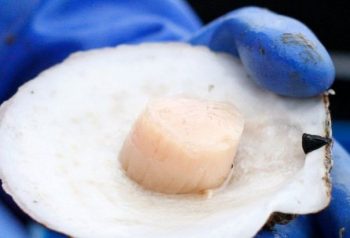
America’s got scallops: Catch is up, consumers shelling out
America’s harvest of scallops is increasing to near-record levels at a time when the shellfish are in high demand and the value of the fishery has surged in recent years. Sea scallops, harvested mostly by boats from the cold Atlantic Ocean, are the target of one of the most valuable fisheries in America. New data from the National Oceanic and Atmospheric Administration says the harvest topped 58.2 million pounds last year, the highest total since 2011 and the fifth-highest in history according to federal statistics going back to 1945. >click to read< 15:30

They’re just pouring money into it -“A Big Fugazi”: Why Fishermen Still Can’t Get Behind Offshore Wind
“This is going to affect every fisherman and fishes around these windmills,” Schneider says. “These crabs, these lobsters, seismic activity bothers them I believe and it’s not benefiting any one of us except a foreign company.” Schneider’s not alone. Fisherman along the Rhode Island and Massachusetts coast fear they could lose a significant portion of their catch. This is especially true for squid fishermen because the wind farm area will be constructed near their fishing grounds.,,,Dr. Kevin Stokesbury is a professor of fisheries oceanography at the University of Massachusetts, Dartmouth. He says the wind farms will be installed in a fairly large homogenous environment in the sea floor, which will change the environment. >click to read<13:29
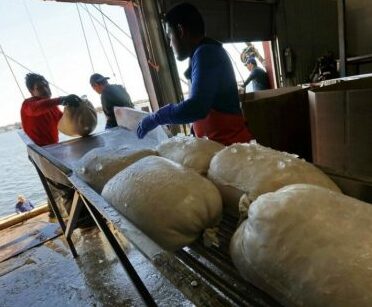
From Port to Plate: A journey of New Bedford’s most profitable product
Who knew that a silver dollar-sized scallop could provide such bang for a buck? As the most profitable item turned over in the most profitable port in the country, this milk-colored mollusk has almost been solely responsible for the re-birth of New Bedford’s working waterfront since the turn of the century. While other New England ports have shrunk or been gentrified from a working waterfront to high rise condos and upscale restaurants, New Bedford has thrived. OUT AT SEA- Captain Earl Chor Sr. described an early 12-day April trip to the Elephant Trunk Flex Access Area as “smooth” despite working around a few days of harsh weather.,, TO THE HIGHEST BIDDER- In the damp and hollowed display room of BASE there are dozens of tall cardboard bins filled with ice and bagged scallops, known as lots, lining the room.,, SPANNING THE GLOBE- click here to read this big story 08:51
New Bedford again tops nation for dollar value of fishing catch
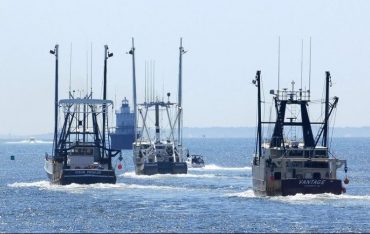 The city’s port has again topped the country for dollar value of its fishing catch, NMFS reported this week, citing 2015 landings worth $322 million. That marks 16 years in a row that New Bedford has held the top-value title, which is thanks largely to scallops. Dutch Harbor, Alaska, again was tops for total volume of catch, landing 787 million pounds last year. “The scallop industry has put New Bedford at the top of the food chain, as it were, of fishing ports for the last 16 years — that’s a very impressive streak,” said Ed Anthes-Washburn, port director for the city’s Harbor Development Commission. “It really shows the impact of scallops but also the impact of cooperative research.” In the 1990s, SMAST scientists Brian Rothschild and Kevin Stokesbury pioneered innovations in counting scallops, with cameras tested and used on local scallopers. The resulting data affected stock assessments by the National Oceanic and Atmospheric Administration (NOAA), ultimately leading to larger catch quotas and helping secure steady catches for waterfront businesses. Read the rest here 19:52
The city’s port has again topped the country for dollar value of its fishing catch, NMFS reported this week, citing 2015 landings worth $322 million. That marks 16 years in a row that New Bedford has held the top-value title, which is thanks largely to scallops. Dutch Harbor, Alaska, again was tops for total volume of catch, landing 787 million pounds last year. “The scallop industry has put New Bedford at the top of the food chain, as it were, of fishing ports for the last 16 years — that’s a very impressive streak,” said Ed Anthes-Washburn, port director for the city’s Harbor Development Commission. “It really shows the impact of scallops but also the impact of cooperative research.” In the 1990s, SMAST scientists Brian Rothschild and Kevin Stokesbury pioneered innovations in counting scallops, with cameras tested and used on local scallopers. The resulting data affected stock assessments by the National Oceanic and Atmospheric Administration (NOAA), ultimately leading to larger catch quotas and helping secure steady catches for waterfront businesses. Read the rest here 19:52
Greg Fulcher betting on scallop permit consolidation to recoup $7m
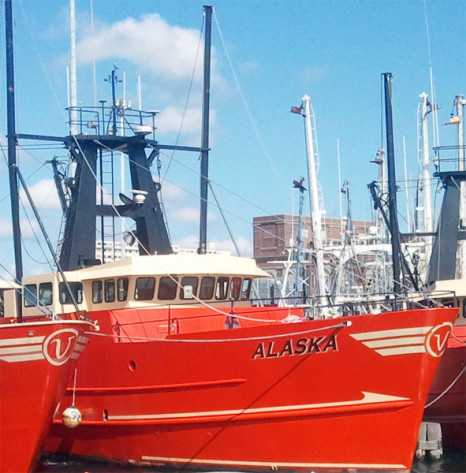 Greg Fulcher — who has just bought the scallop vessel Alaska, and fishing permit, for a record-high sum of $7 million — believes sector consolidation will bring management changes in the US. It’s the potential for these changes that makes the amount he paid, to Oceans Fleet Fisheries, worth while. “With the amount of money coming into the industry at the moment; the players and the consolidations; I expect individual quotas are on the way,” he said, referring to a quota system based on allowing individuals to fish their allocated amounts as they see fit, including using fewer, larger vessels. Sadly, Read the rest here 10:12
Greg Fulcher — who has just bought the scallop vessel Alaska, and fishing permit, for a record-high sum of $7 million — believes sector consolidation will bring management changes in the US. It’s the potential for these changes that makes the amount he paid, to Oceans Fleet Fisheries, worth while. “With the amount of money coming into the industry at the moment; the players and the consolidations; I expect individual quotas are on the way,” he said, referring to a quota system based on allowing individuals to fish their allocated amounts as they see fit, including using fewer, larger vessels. Sadly, Read the rest here 10:12
Scallop Sparks flying in advance of New England Fishery Management Council meeting
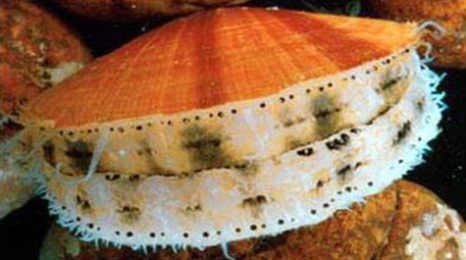 The scallop industry is on high alert over next week’s meeting of the New England Fishery Management Council after a long warning letter was sent to the council by NOAA
The scallop industry is on high alert over next week’s meeting of the New England Fishery Management Council after a long warning letter was sent to the council by NOAA Fisheries Regional Administrator John Bullard. The council’s Habitat Committee has issued recommendations that fishing restrictions be lifted on several areas of Georges Bank, the Gulf of Maine and the South Channel. But Bullard, backed by his agency’s scientific staff, said he believes that the relaxing of the restrictions would set back the effort to nurse fish stocks back to health. Read the rest here 22:03
MSA Reauth Road Show: Fisheries Survival Fund responds to Conservation Law Foundation attack on scallop industry testimony

 FSF did not say management has failed but rather changes are needed to provide flexibility and consistency to meet market demands. Industry has proven its stewardship of the resource. Maintaining all closures allows the scallops to age and die, providing no benefit to communities. Allowing access into some closed areas will introduce more areas into the rotational system allowing a more consistent scallop catch without threatening the sustainability of the scallop fishery. more here 23:15
FSF did not say management has failed but rather changes are needed to provide flexibility and consistency to meet market demands. Industry has proven its stewardship of the resource. Maintaining all closures allows the scallops to age and die, providing no benefit to communities. Allowing access into some closed areas will introduce more areas into the rotational system allowing a more consistent scallop catch without threatening the sustainability of the scallop fishery. more here 23:15
Scallops giving New Bedford fishermen a welcome break – Lucrative shellfish lift fishermen — and the port they call home
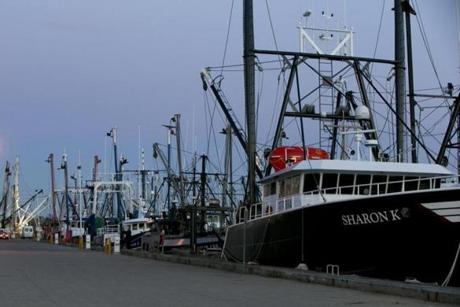 NEW BEDFORD Gail Isaksen remembers when the commercial fishing industry in New Bedford Harbor collapsed in the mid-1980s: Cash-strapped boat owners scrimped on maintenance, borrowed to buy supplies they couldn’t afford, only to see their livelihoods destroyed. “I have a list of guys who still owe me money,” said Isaksen, 68, the owner of Fairhaven Shipyard. “I’m not getting paid. They’re not coming back.” Today, though, Isaksen’s shipyard is busy again with customers who can afford to pay: scallop fishermen. more@bostonglobe 10:21
NEW BEDFORD Gail Isaksen remembers when the commercial fishing industry in New Bedford Harbor collapsed in the mid-1980s: Cash-strapped boat owners scrimped on maintenance, borrowed to buy supplies they couldn’t afford, only to see their livelihoods destroyed. “I have a list of guys who still owe me money,” said Isaksen, 68, the owner of Fairhaven Shipyard. “I’m not getting paid. They’re not coming back.” Today, though, Isaksen’s shipyard is busy again with customers who can afford to pay: scallop fishermen. more@bostonglobe 10:21
MSA Re-Auth Roadshow: ENGO Perspective! Scallopers Haul Back a Short-Sighted Vision
 Scallop industry lobbyist Drew Minkiewicz argued that the scallop industry was so well self-managed, so willing to reinvest its gold into critical research and development that the American taxpayer was apparently resisting paying for, so sea-turtle-friendly, so responsible, and so much—well—better than the federal government that the scallop fishery should just be turned over to the fleet to manage itself. (this from a lousy lawyer that defends the NMFS better than they can, then turns around and threatens to sue them!!) CONTINUOUSLY – Bad Petey. more@talkingfish 18:08
Scallop industry lobbyist Drew Minkiewicz argued that the scallop industry was so well self-managed, so willing to reinvest its gold into critical research and development that the American taxpayer was apparently resisting paying for, so sea-turtle-friendly, so responsible, and so much—well—better than the federal government that the scallop fishery should just be turned over to the fleet to manage itself. (this from a lousy lawyer that defends the NMFS better than they can, then turns around and threatens to sue them!!) CONTINUOUSLY – Bad Petey. more@talkingfish 18:08
Bad Petey must’ve missed this testimony by Dr. Kevin Stokesbury, probably the most important of all, for if he had, he wouldn’t have published such a nasty little rant. What would compel someone as narrow minded as he, to mock a real attorney that isn’t on the ENGO dole? Something to think about anyway, and Stokesbury’s testimony will explain why. Link
NOAA – Forward Thinking Measures To Benefit Scallop Fishermen and Resouce (sic)
“We have a long term vision for this resource and confidence in our research surveys that show we had unprecedented recruitment (abundance of young scallops) in the Mid-Atlantic in 2012,” said scallop industry representative, Peter Hughes of Atlantic Capes Fisheries. Annual surveys of the scallop resource conducted by NOAA Fisheries, the Virginia Institute for Maine Science and the School of Marine Science and Technology at the University of Massachusetts, Dartmouth, showed a high number of small scallops in 2012, particularly in the Mid-Atlantic. In recent history, the only year when the number of small scallops was greater was in 2001. Read more here
Ripples from disruptions in the fishing industry will reach a long way By DON CUDDY
They say bad news comes in threes, and that seems to be the case in the New Bedford fishing industry these days. On top of a recent declaration from the secretary of commerce that the groundifsh industry in New England is a national disaster, the scallop fleet is looking at catch reductions of 30 percent for the next two years. And groudfishermen are resigned to more drastic cuts to their quota for the next fishing year, which begins on May 1.
Frustration over the cuts is mounting on the waterfront because fishermen have their doubts about the accuracy of NOAA’s stock assessments.
“There’s more yellowtail now than there were in the ’60s,” said Reidar Bendiksen of Reidar’s Manufacturing in Fairhaven, a family business that makes trawl gear. “But the fishermen can’t go where they are, and they are not allowed to catch them.”
http://www.southcoasttoday.com/apps/pbcs.dll/article?AID=/20121014/NEWS/210140346
Scallop Actions: NEFMC September 25 – 27, 2012 in Plymouth, Massachusetts.
,,,,,,,,,,quota for the U.S. and Canada to share for Georges Bank yellowtail, leaving the U.S. share in the low 200’s—an amount considered insufficient by the scallop harvesting industry. In contrast, the New England Council’s Scientific and Statistical Committee (SSC) recommended consideration of an overall quota of 1,150 mt. The Council did not vote to approve the TMGC-recommended level, and will consider the quota level recommended by the SSC as well. The Council did not move forward with the SSC recommendation that there be no possession of Georges Bank yellowtail. Read More
Yellowtail flounder giveaway will not harm scallopers this year
The scallop fleet heaved a collective sigh of relief Friday when NOAA Fisheries announced the industry would not suffer for a good deed. Every year, groundfishermen and scallopers share the allowable catch of yellowtail flounder on Georges Bank. In June, to help groundfishermen struggling with low catch limits, the scallopers gave the dragger fleet 150 metric tons of yellowtail quota, half of their 2102 allocation. That equals more than 800,000 pounds of fish. Alarm bells began to ring when figures emerged showing the scallop fleet had taken about 136 metric tons of its remaining 150-ton allotment as of Wednesday — more than 90 percent — with five months remaining in the current fishing year. However, a NOAA Fisheries release Thursday eased fishermen’s concerns. The scallop fishery is exempted “from accountability measures for any Georges Bank yellowtail flounder catch below their initially allocated 2012 catch limit of 307.5 metric tons,” the press release said. Scallop boat captain Tom Quintin on the Patience said the news came as a relief to him. “I was just telling my boss we shouldn’t have given the yellowtail away when I heard we’d caught almost all of the quota,” he said. Boat owner Dan Eilertsen said the news was reassuring. “I have 13 trips left that I could have lost if they had shut us down. So I am glad to hear that,” he said. But Eilertsen, who owns the Liberty, Justice and Freedom, said scallopers would not have agreed to the transfer initially without assurances that it would not hurt them. “That’s what eased the deal,” he said. http://www.southcoasttoday.com/apps/pbcs.dll/article?AID=/20120929/NEWS05/209290325/-1/SPECIAL77






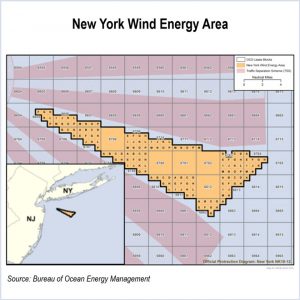 The U.S. District Court for the District of Columbia decided late Wednesday not to grant a preliminary injunction in the lawsuit brought by a host of fishing communities, associations and businesses led by scallop industry trade group the Fisheries Survival Fund against the impending leasing of the New York Wind Energy Area to Statoil Wind of Norway. The suit alleges the U.S. Bureau of Ocean Energy Management (BOEM) leasing process did not adequately consider the impact of wind power development in the waters off Long Island, New York on the region’s fishermen. The fishing industry asked that the court temporarily halt BOEM from proceeding with the final ratification of a lease on the area, which was preliminarily awarded to Statoil, Norway’s state oil company, for $42.5 million. “Getting a preliminary injunction granted is difficult, given the high standards that the court applies,” said Mayor Kirk Larson of Barnegat Light, N.J., one of the plaintiffs in the case. “But our case will continue, and we are confident that we will succeed on the merits.”
The U.S. District Court for the District of Columbia decided late Wednesday not to grant a preliminary injunction in the lawsuit brought by a host of fishing communities, associations and businesses led by scallop industry trade group the Fisheries Survival Fund against the impending leasing of the New York Wind Energy Area to Statoil Wind of Norway. The suit alleges the U.S. Bureau of Ocean Energy Management (BOEM) leasing process did not adequately consider the impact of wind power development in the waters off Long Island, New York on the region’s fishermen. The fishing industry asked that the court temporarily halt BOEM from proceeding with the final ratification of a lease on the area, which was preliminarily awarded to Statoil, Norway’s state oil company, for $42.5 million. “Getting a preliminary injunction granted is difficult, given the high standards that the court applies,” said Mayor Kirk Larson of Barnegat Light, N.J., one of the plaintiffs in the case. “But our case will continue, and we are confident that we will succeed on the merits.”


























